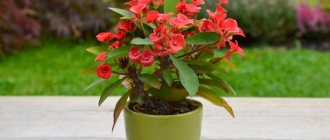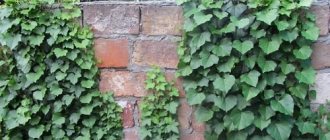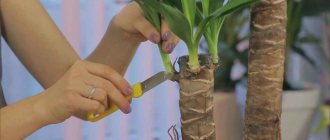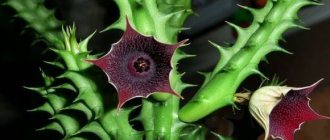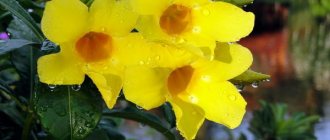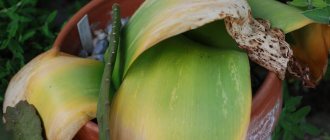Cymbidiums are large flowers from the orchid family. To wait for flowering after a planned transplant, you will have to be patient. The choice of a new container for growing cymbidium is very important. What kind of pot is needed, the most suitable soil for the plant - all these nuances are important to know and follow in order to still see delicate flowering in the spring.
Description of the origin and appearance of the cymbidium orchid
In the large Orchid family there is a special flower - the cymbidium, which is naturally found at an altitude of about two to three thousand meters above sea level in the subtropical forests of northern India, Thailand, Vietnam, Japan and Burma. Some members of the genus grow in northern Australia. This orchid was first cultivated in China more than two thousand years ago. At that time, cymbidium was considered the king of fragrances and the imperial chambers were decorated with it.
Orchids of the genus Cymbidium were first described scientifically in 1799 by Swedish naturalist Peter Olof Swartz.
Under natural conditions, these orchids grow as epiphytes and lithophytes. They are located in tree hollows, on large branches, on rock ledges, clinging with their roots to cracks in the bark and stones.
Under natural conditions, Cymbidium mainly grows in tree hollows.
Most Cymbidium species have characteristic ovoid pseudobulbs (thickened near-earth parts of the stem in which epiphytic plants retain moisture). They can reach 15 cm in length. The leaf blades are leathery, sword-shaped, with pointed tips. The color is golden-green.
The orchid got its name due to the structure of its lip, which resembles a boat. "Cymbidium" translated from Greek means "boat-like".
Cymbidium is a very large orchid; its flower stalk can reach 1.2 m in height. The flowers are collected in a loose “tassel” or “panicle” hanging down. The size of the buds depends on the species. There are both miniature (2 cm in diameter) and very large (about 20 cm) flowers.
The petals are painted in different shades of yellow, pink, brown, red. In nature, they and the sepals are always the same color, and the three-lobed lip is most often variegated and bright. You can enjoy the look and aroma at home from one and a half to three months. A cut flower does not fade for a very long time, even without water.
Cymbidium flowering lasts for at least one and a half months
Types of orchids popular among gardeners
The genus Cymbidium has many representatives. Not everything is known to floriculture lovers. There are also selective hybrids. Most often at home you can find:
- Cymbidium eburneum (ivory). It is distinguished by large flowers (12 cm in diameter) of an exquisite cream color with a slight pearlescent sheen. Valued for its incomparable aroma, reminiscent of lilac.
- Cymbidium aloelia. The height of the plant is no more than 30 cm. The flowers are pale yellow with a burgundy lip. Diameter - 4.5 cm.
- Cymbidium lanceolifolia. The flower is of unusual color; the sepals and petals are light green with thin dark scarlet veins. The lip is snow-white with a pattern of brick-colored spots and stripes.
- Cymbidium Tracy. The height of the peduncle is about 1.2 m. The flowers are large (15 cm in diameter), yellow-green with red-brown streaks. The lip has a wavy and sometimes fringed edge, creamy, covered with small scarlet spots.
- Day's Cymbidium. The orchid inflorescence is very spectacular, with numerous flowers, the diameter of which is 5 cm. The petals and sepals are painted in noble shades of “ivory”. The lip is snow-white, its front blade is curled.
- Cymbidium Lowe. Very large flowers (20 cm in diameter), the petals of which have a greenish-yellow tint, and the lip is dark crimson with a yellow border. The plant reaches 1 m in height.
- Cymbidium swordifolia. Lithophyte. The flowers are incredibly fragrant, up to 5 cm in diameter. The sepals and petals are light yellow with burgundy veins. The lip is greenish, with dark red specks in the middle and brown stripes on the sides.
- Cymbidium is yellowish-white. Found naturally in the Himalayas. The orchid is large. The diameter of the fragrant flowers is 7.5 cm. The buds are cream-colored, and the lip is yellowish with red specks.
- Cymbidium dwarf. A very rare plant, originally from Japan. It is distinguished by red-brown petals with a yellow border around the edges. The lip is white with dark red spots, the shape of the middle blade is curved.
- Cymbidium giant. A plant with very large flowers (15 cm in diameter), emitting a strong aroma. The petals are yellow-green and covered with red strokes; the cream-colored lip is decorated with spots and stripes. Some breeding hybrids have predominant red shades. The length of the inflorescence is about 60 cm.
- Cymbidium is wonderful. The species is distinguished by a large, beautifully flowing inflorescence up to 80 cm long. The diameter of the flowers is 7–8 cm, they are painted pale pink and mottled with red spots.
Photo gallery: species grown at home
Eburneum is valued for its incomparable aroma, reminiscent of lilac. Cymbidium aloelia is a compact orchid
The sepals and petals of lanceolate cymbidium are light green with a dark red vein.
Cymbidium Tracy is a very large orchid, the flower stalk of which grows up to 1.2 m
The petals and sepals of Day's cymbidium are colored in various shades of ivory.
Cymbidium Lowe grows up to 1 m in height
Cymbidium swordifolium is a lithophyte, that is, a terrestrial orchid that grows directly on stones
The buds of Cymbidium are yellowish-white and colored cream, and the lip is yellowish with red speckles.
Cymbidium dwarf is a very rare plant native to Japan.
The petals of giant cymbidium are yellow-green and covered with red strokes.
The flowers of the remarkable Cymbidium are pale pink and speckled with red spots.
How to choose the right plant?
Modern breeders have developed a huge number of hybrid forms adapted for cultivation “in captivity”. Most often in flower shops you find just such plants, and not “natural” plants. When choosing, you need to pay special attention to the condition of the roots, leaves, peduncle and the age of the orchid.
It is ideal if the cymbidium has a well-developed root system. Assessing its condition is not difficult, since orchids are usually sold in transparent plastic containers. A healthy plant has fleshy, olive-colored roots. Well, if their tips are bright green, this means that the orchid is in an active growth phase. Inspect and touch the aerial roots. They should be elastic. Softness and “hollowness” mean that the plant will have to be revived at home, and this labor-intensive procedure does not at all guarantee a positive result.
Most often in flower shops you can find selection hybrids of Cymbidium
A healthy orchid has dense and elastic leaf blades of a light green tone with a reddish edging along the edge. There should be no plaque, spots or dots. You should not buy an orchid with wrinkled and limp leaves. A dark green color indicates that the cymbidium did not have enough light, and a reddish or yellowish tint indicates an excess of it. It is best to refrain from purchasing a plant with such problems.
An important factor to consider when choosing a cymbidium is the age of the orchid. A mature plant is large, it is capable of blooming profusely and producing offspring.
Most often, when choosing an orchid, the first thing to pay attention to is its flowering. Estimate the number of blooming flowers and buds; the more, the better. Once in the apartment, the orchid experiences severe stress and needs time to adapt to new conditions. Therefore, she can discard the opened flowers. This is fine.
Be sure to inspect the growing point. It should be elastic and hard to the touch. Any stains and mucus are a reason to refuse the purchase.
Planting and transplanting
It is advisable to replant the cymbidium orchid every 3 years. Transplantation is done after flowering has ended. If the plant is healthy, bloomed well, and is properly cared for, then each green bulb produces 1–2 babies per season. The main point of reproduction is just good care. If it is there, then there will be no difficulties with division.
Cymbidium is replanted infrequently - once every 3 years
What soil to choose
The ideal soil for Cymbidium orchids is the bark of coniferous trees. Why conifers? Because this type of orchid loves acidic soil, and this is precisely what the crushed bark of coniferous trees provides.
If you decide to make the substrate yourself, then the ratio of the component parts is as follows:
- 3 parts pine bark,
- 2 parts sphagnum moss,
- 1 part sand
- 1 part perlite
- 1 part charcoal.
There is no urgent need to make this planting mixture yourself. Nowadays, any flower shops sell ready-made soils for orchids. Feel free to use them.
The pot should not be large in volume, otherwise the plant will “fatten”, growing a large leaf mass, but not bloom. The size of the planting pot should be slightly larger than the orchid's root system.
When is it time to replant?
How do you know if it’s time to transplant an orchid into a new pot or if it’s not time yet? Everything is very simple. Look at the center of the plant pot. If the greenery around the edges is very thick, and the roots fill the container so much that it is impossible to insert a pencil, then the time has come to replant the flower.
This orchid needs a transplant
Step-by-step transplant
- Remove the cymbidium from the pot.
- As a rule, the roots of a transplanted plant grow strongly together. To unravel them, you need to lower the plant into a container of warm water.
- In the middle of the root system you can see dry roots that are gray in color or rotten ones that are soft and black.
They need to be removed with a sharp knife. This must be done carefully and carefully so as not to damage the young root system. Dry and damaged roots are removed - After removing everything dry and rotten, you need to leave the orchid for 10 minutes so that the wounds, sprinkled with activated carbon or cinnamon, dry.
- Pour drainage into a new pot, and lay fresh substrate on top, in a layer of at least 3 cm.
- Then you need to put the plant in a pot, carefully placing the roots among the substrate, which should be moistened by this moment.
- The cymbidium transplanted into a new container is placed in a dark place, here it will take root and recover from stress.
Conditions required by the flower depending on the season
Compared to other orchids, cymbidium is considered unpretentious, but this does not mean that you can forget about the purchased plant. Regular flowering is possible only in conditions close to optimal. Therefore, it is worth listening to the “wishes” of the flower, because the microclimate of its homeland is not at all similar to that created in modern apartments.
Table: how to create an optimal microclimate for cymbidium
| Season | Lighting | Humidity | Content temperature |
| Spring Summer | The orchid is very photophilous, but the plant can get burned from direct sunlight. The ideal option would be to place it on a window with a southern or eastern orientation, but it is better to shade the plant with tulle from the scorching sun. | Humidity should be at least 50–60%. On hot days, you should spray the cymbidium as often as possible, and also install an air humidifier, decorative fountain or tray with wet pebbles near the plant, from which the water will evaporate. | 25–30°C during the day and 14–15°C at night. It should be borne in mind that such a temperature difference is a necessary condition for flowering. |
| Autumn winter | The orchid needs to be illuminated with fluorescent lamps or special phytolamps. Cymbidium should be exposed to light for up to 12 hours a day. | The number of sprays should be reduced to once a week if the air in the room is too dry. Please note that if kept cool, you should discard them completely, as the orchid may rot. | Cool wintering with temperatures of 14–16°C during the day and 10–12°C at night. |
Brief description of cultivation
- Bloom . As a rule, in winter for 4–6 weeks.
- Illumination . This plant needs a long day, and the light should be diffused but bright. In winter, the bush needs artificial lighting.
- Temperature regime . In the warm season, the temperature should be room temperature, and shortly before the start and during the flowering period - no more than 16 degrees.
- Watering . During the growing season, water frequently and with plenty of water, and before flowering - 2 times a month.
- Air humidity . It should be at the level of 50–60 percent. To increase humidity in the summer, it is recommended to moisten the foliage with a spray bottle three times a day, and place the pot with the plant on a tray filled with wet pebbles.
- Fertilizer . Regularly, after every third watering, the bush is fed with a fertilizer solution for orchids.
- Rest period . Not clearly expressed.
- Transplant . Regularly once every 2 or 3 years.
- Reproduction . Dividing the bush.
- Pests . Scale insects, spider mites and aphids.
- Diseases . Sooty fungus, gray and brown rot, and also viral mosaic.
Flower care at home
Cymbidium, like any orchid, needs regular attention. There is nothing difficult in growing it if you familiarize yourself with the rules for caring for the flower in advance and follow them.
Features of watering and fertilizing
In spring and summer, cymbidium requires abundant watering. However, you should keep in mind that water should not stagnate in the pot and tray, as the roots may rot and you will lose the plant. With a lack of moisture, the pseudobulbs shrink and the buds fall off.
You can water the orchid like an ordinary houseplant, moistening the substrate from a watering can, or using the immersion method, pouring warm water into a basin and placing a pot of cymbidium in it for half an hour. When the substrate is sufficiently saturated with moisture, its excess must be drained from the pan. At the end of autumn, the number of waterings should be reduced to once every two weeks, and with the onset of spring warmth, return to the usual schedule.
During the flowering period, cymbidium does not need feeding.
It is recommended to apply fertilizer with every third watering in the spring-summer period. Special products for orchids, for example, Kemira Lux, Ideal or Rainbow, are great for this. It is most convenient to use liquid fertilizers; they must be diluted according to the instructions and watered the plant after moistening the substrate with plain water.
Orchid blossom
There are many species in the Cymbidium genus, which bloom at different times of the year. To find out exactly when it occurs in your plant, ask the seller when purchasing an orchid for its exact name. However, any of the specimens will not set buds unless the necessary conditions are met.
If the required conditions are met, cymbidium blooms profusely and on time.
Firstly, the flower is reluctant to bloom in extreme heat; the optimal temperature for this is 22ºC. Secondly, bright sunlight is important. And thirdly, it is imperative that the orchid grows with a difference in night and day temperatures of approximately 5ºC. If the flower lives in a room with heating, in which this indicator almost does not change, then you need to arrange such a “swing”, moving the pot closer to the window at night. In the summer, you can take the cymbidium out into the garden or onto the balcony; under natural conditions, the orchid tolerates cold nights well. It is thanks to them that it will bloom on time and abundantly.
When all the buds have fallen, it is recommended to remove the cymbidium peduncle, leaving a stump about 3 cm high.
Rest period
A period of relative rest for cymbidium begins after flowering ends. Drying of the peduncle is a sign that the plant is beginning to rest. At this time, lower the temperature of the orchid, reduce the number of waterings and completely stop feeding.
Video: important nuances of plant care
Appearance of flower stalks
To achieve the appearance of pseudobulbs, that is, flower stalks, you need to follow the watering regime and provide the plant with a normal temperature. Flowering time is mid-spring. The flower does not like the intense summer heat of Russian latitudes. That is why all transplants are done in March - February.
During the cold period of the year (October - March), the suitable temperature for keeping cymbidiums is up to 20° C during the day, and at night - 10 - 12° C. But as soon as the first buds outside the window begin to bloom, you can already start replanting the cymbidium.
It will be difficult to see cymbidium blooming in an apartment. You can force an orchid to produce a bulb when the growing conditions are ideal for it.
It is necessary to shade the windows and maintain a strictly certain temperature in the room during the day and a suitable temperature at night. The main condition for the blooming of buds is temperature changes. However, small varieties of the flower are more accustomed to climate conditions in mid-latitudes. A daily temperature difference of 5−8°C is enough for them .
These are the varieties that are best kept in an apartment. Large and large-leaved varieties, such as cimbidium grrootblomig joel, need a daily difference of 10 to 15°C. There is no need to be afraid of the flower freezing. Cymbidiums are accustomed to mountainous areas and can withstand very low temperatures - about 3-5 degrees Celsius at night.
How do errors in caring for cymbidium manifest themselves?
Any mistakes made by the grower immediately affect the appearance of the plant, which dramatically loses its decorative value. If nothing is done, the orchid will stop blooming and may even die. Therefore, you need to learn how to correctly interpret the “signals” sent by cymbidium and know how to react to them.
Table: what does an orchid look like that is not cared for correctly
| Problem | Possible reason | How to fix the situation |
| Black spots appear at the base of the leaves. | Overmoistening of the substrate. | Cut off all damaged leaves and adjust the watering regime. The substrate should dry well between procedures. |
| The buds fall off without developing. | Lack of microelements in the soil. | Feed the plant with complex mineral fertilizer: water the soil with the solution, spray the leaves. Don't forget about this in the future. |
| Pseudobulbs shrink. | Insufficient watering. | Water the plant with soft filtered water. Adjust the mode, avoiding overdrying the substrate. |
| The roots are rotting. | Overwatering. | Remove the orchid from the pot, clean the roots from the soil, cut off all rotten parts. Treat with Zircon and transplant the plant into fresh substrate. After this, do not water for two to three days. |
| The leaf blades turn red and fall off. | Excessive lighting. | Move the container to a bright place, but without direct sunlight, or shade the flower with tulle. |
| The buds dry out without blooming. | Too little watering or the cymbidium is damaged by pests. | Adjust the watering mode. Give your cymbidium a warm shower. Inspect for pests. If they are found, treat with insecticides (according to the instructions). |
| Leaf blades turn yellow. | Sunburn or poor watering. | Move the flower to another place or shade it with tulle. Adjust watering. Use the immersion method. |
Secrets of care
The health of the orchid depends on proper care.
How to water correctly
This process has its own characteristics. They practice 2 types of watering - soldering and immersion.
- When using the immersion method, the pot with the plant is placed in a container filled with water. The pot should be in liquid almost to the very top. The entire procedure takes 40–45 minutes. During this time, the substrate is thoroughly impregnated with water.
- The second method is soldering. It differs from the first one in that the plant is placed in an empty container and watering is carried out from above. So we moisten until the water reaches almost to the top of the pot. The substrate is completely wetted very quickly, in 10–15 minutes. After such watering, the plant can not be disturbed for about 10 days.
How to find out about the need to water an orchid? Since this flower is usually planted in transparent pots, it is easy to determine the moment when the plant needs watering. As soon as the condensation on the inner walls of the pot disappears, the roots lose their greenish color, become light and silvery, this is a signal that it is time to water the plant.
It is very important to properly water the cymbidium orchid, since the health of the plant depends on this and whether it will please its owners with flowering. In summer and winter, the frequency of humidification is different. In winter, as a rule, there is little light and plant development slows down. Accordingly, watering is carried out less frequently.
When watering, it is very important to ensure that water does not get into the axils of the leaves covering the pseudobulb. If even a drop of moisture gets there, you need to remove it with a paper napkin, which will absorb the liquid, or simply tilt the plant and the water will drain.
Seasonal watering table
| Season | Water temperature | Number of waterings |
| Spring | 25º-27ºС | Once every 7–8 days |
| Summer | 25º-27ºС | Once every 7–8 days |
| Autumn | 25º-27ºС | Once every 10–12 days |
| Winter | 26º-30ºС | Once every 14–15 days |
Top dressing
Feeding an orchid is simple. Special fertilizers are sold in flower shops. It is preferable to use Ideal, Rainbow, Kemira Lux. These are proven and high-quality fertilizers. Fertilizer application should be combined with every 3rd watering. This applies to the spring period. In June and July, you need to reduce the application of nitrogen fertilizers. Examine an orchid and you will definitely see what the plant is missing. For example, if you notice yellowing leaves, then perhaps there is not enough potassium in the soil. If a plant grows slowly and appears to be in a stunted state, it most likely lacks nitrogen. When a leaf is weakly colored and loses its elasticity, this indicates a lack of magnesium.
The solution to these problems will be the use of fertilizers with a high content of the element missing by the plant.
When the first flower stalks appear on the cymbidium, stop feeding until flowering stops completely.
You can use a commercial orchid mixture as soil. If you prefer to prepare the substrate yourself, then take conifer bark, sphagnum, charcoal, vermiculite, coarse sand and leaf soil. Mix until the soil is loose. The drainage layer must be thick.
Fertilize with special fertilizers for orchids. Fertilizers are applied once every 2 weeks at half the recommended dose. In winter, you should choose fertilizers with a low nitrogen content.
Bloom
The duration of flowering varies among different varieties of cymbidium. But all varieties and types of this orchid have one thing in common - they will never bloom if the air temperature exceeds +22ºC.
How to make cymbidium bloom?
In order for the cymbidium to bloom, it is necessary to create suitable conditions for it, as close as possible to the mountainous areas that were its original habitat. What are these conditions?
- First of all, the difference between day and night temperatures is at least 4–5ºC. It is the difference that stimulates the formation of buds. If an orchid grows in a garden or greenhouse and its flowering occurs in spring and summer, then there is no need to specially adjust the temperature regime. But in winter, heating is turned on in houses and temperature fluctuations here are more difficult to achieve. If you have an insulated loggia, then you can place the plant there at night. Cymbidium orchid tolerates temperatures down to 5–6ºC without any problems. And in this case you will definitely achieve flowering.
- You also need bright light, but with shading from the direct rays of the sun.
The largest flowers appear on the plant in the 3rd year of life. At this time, up to 25–30 flowers can bloom on the cymbidium peduncle! And this spectacle can be enjoyed for more than 2 months.
As soon as the orchid stops blooming, know that the plant is preparing for a period of rest. To provide him with comfortable conditions while he rests, it is necessary to do pruning. If this is not done, then after some time the cymbidium will gather its strength and bloom again. But this greatly weakens the flower, it can get sick and even die.
What to do with the peduncle after flowering?
The orchid has faded, but the peduncle is still green. What should I do? Wait to see if it starts to dry on its own. And if this is exactly what happens, let the plant get all the nutrients from the peduncle and only then cut it off.
Has the flower stalk turned completely yellow? You can start removing it. The cut should be made so that a small stump remains at the base, about 1–1.5 cm.
How to care during the dormant period?
Some orchids do not need a rest period. But for cymbidium this period is a physiologically necessary condition. In nature, this time occurs during unfavorable weather conditions. Being able to freeze for a while helps the plant more easily tolerate cold temperatures, drought or scorching heat.
Cymbidium usually goes to rest at the end of October or beginning of November. At this time, a noticeable change occurs in the content of the plant. The frequency of watering is reduced to a minimum - once every 14-15 days, the air temperature drops to 10-12ºC. Such changes in the life of an orchid help flower buds to form and produce abundant blooms next season.
Diseases and pests of cymbidium
If not properly cared for, cymbidium suffers from fungal diseases and viral infections. The flower can also be bothered by mealybugs, scale insects and aphids.
Table: diseases and pests that often affect cymbidium
| Diseases and pests | Signs | Reason for appearance | Treatment and prevention measures |
| Viral mosaic | Leaves curl, flowers become deformed, and light spots appear on the petals. | Overmoistening of the substrate. | There is no treatment; the plant must be destroyed. As a preventative measure, do not allow the substrate to become excessively damp. |
| Fusarium wilt | In the place where the leaf blade connects to the stem, black depressed spots appear. The leaves “crumple” and fall off. | Waterlogging or salinization of the soil | Cut off the infected parts to healthy tissue, treat the sections with brilliant green or iodine. After the “wound” has dried, spray it with Fundazol. Plant the plant in fresh substrate. |
| Chlorosis | There are yellow stains on the leaves. | Micronutrient deficiency, especially iron | Carry out foliar feeding by spraying the leaves with a solution of complex fertilizers. When watering, use exclusively soft, settled water, since tap water causes the soil to become saline, and excess calcium compounds, in turn, prevent iron from being absorbed. |
| Root rot | Leaves and shoots turn black. Mold appears on the root collar. There is a characteristic putrid odor. | Excessively abundant watering, low temperature. | The diseased flower should be destroyed. To prevent disease, water your orchid properly. Do not allow moisture to stagnate. |
| Aphid | A whitish coating and sticky drops appear on the leaf blades and stem. Large clusters of insects are visible. | The indoor air is too dry. | Wash the plant thoroughly with soapy water and give the orchid a shower. Spray the flower with Fitoverm or another insecticide (according to the instructions). To prevent the appearance of aphids, maintain high air humidity (it should be at least 60%). Do not allow water to accumulate at the base of the leaves; water and spray the flower regularly. |
| Shchitovka | Brown tubercles appear on the leaf blades. The leaves are turning pale. | Low humidity in the room. | You can get rid of scale insects by mechanically processing cymbidium. Scrape off the bumps and wipe all parts of the plant with a cotton swab dipped in soap suds. Treat the flower and soil with Phosbecide, Metaphos. |
Photo gallery: diseases and pests typical of cymbidium
There is currently no cure for viral mosaic
An orchid affected by fusarium quickly loses its leaves
In the early stages of the disease, you can try to save an orchid infected with rot fungus by replanting it in a new pot, changing the soil and cutting off all diseased roots
Aphids are the most “universal” pest of indoor plants; they will not disdain cymbidium either.
The scale insect is protected by a durable shell, so folk remedies in the fight against it are ineffective
What you need to know when choosing cymbidium
When going to a flower shop, you need to know how to choose a healthy plant, which in the future will only delight you with its beauty. Of course, you need to pay attention to the beauty of flowers. But that's not important. The main thing is to distinguish a healthy specimen from a sick one, and also take into account several aspects:
- An orchid is a child of the tropics, and if the outside temperature approaches 0ºC or drops below, this is not the best time to purchase a delicate flower. Even a short stay at such a low temperature can be detrimental to an orchid. Therefore, it is better not to take risks and postpone the purchase to a warmer time of year.
- Very often you can see in large supermarkets free-standing shelves with a wide variety of colors. Here they rarely receive proper care. And they get sick much more often than those sold in flower shops, greenhouses and greenhouses. That is why it is better to find specialized stores or centers in advance and go shopping where you can get not only a healthy flower, but also a full-fledged consultation with a specialist.
- Consider whether it is worth buying a plant that blooms profusely. Do not forget that it spends a lot of energy on the growth of flower stalks; flowering exhausts the orchid. And she still has to move into your apartment, adapt to the new atmosphere, temperature and humidity. All this may be beyond the capabilities of a profusely blooming orchid and it may get sick, even if you purchased an absolutely healthy plant. This does not mean that you need to buy a young plant that is not flowering. It's best to settle on the golden mean. Either the flower stalks have just begun to bloom, or there are only a few of them.
- Before purchasing an orchid, look carefully at how firmly it is planted in the pot. Very carefully, at the very base of the stem, move the plant slightly. If this happens, it means it was recently replanted and it has not yet had time to catch its roots on the soil. It is not advisable to purchase such a plant. Immediately look at the roots. Since the orchid is planted in transparent pots, this is not difficult to do. They should be elastic, not wrinkled or dry. Have a light green or white color if the flower sits in a dry substrate. If it has been recently watered, the color of the roots may be dark green. Neither gray nor brown should be present. Don't worry if your orchid's roots are hanging out of the pot. This is just normal. The main thing is that they are alive. The root system is the most important part, which not only supplies the plant with moisture, but also participates in the process of photosynthesis.
- Pay attention to the orchid leaves. If the leaves are dense, elastic, without damage and have the same shape, this is a good sign. If you notice any stains or scratches, then it is better not to take such plants, as the orchid will need a lot of strength to recover. Look at the growth points. They must not be damaged.
It is advisable to avoid purchasing orchids with damaged leaves.
Cymbidium propagation
Cymbidium reproduces by dividing the bush and by seeds. Moreover, the second method is usually used only by breeders, since under normal conditions it is very difficult to obtain plants from such planting material. In addition, seedlings will bloom only in the fifth or sixth year of life and will not inherit the features of the mother plant.
Dividing the bush
At home, the cymbidium orchid reproduces, as a rule, exclusively vegetatively (by dividing the bush).
When dividing the bush, leave at least 2-3 pseudobulbs with sprouts on each part
- Examine the plant and count the number of pseudobulbs. Each division should have 2-3 pieces with sprouts.
- Divide the bush into parts using a sharp, disinfected knife. Powder the sections with crushed activated carbon or lubricate them with brilliant green. Set aside the sections for 1 hour to allow the “wounds” to dry.
- Old leafless pseudobulbs should not be thrown away; they are also capable of producing offspring. Place them on a mixture of bark and sphagnum moss and spray them with water periodically.
- Plant the cuttings with leaves in pots with the same substrate, adding small pieces of charcoal. Pseudobulbs must be on the surface of the soil.
- Place the containers on a bright windowsill and periodically spray the young plants. Cymbidium pseudobulbs grow roots well, and after 1–1.5 months it will be possible to transplant the plants into soil for adult orchids and move them to a permanent place.



